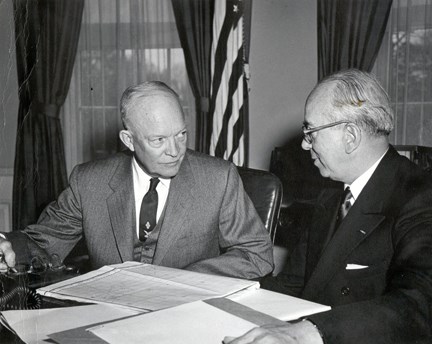Part of a series of articles titled Minuteman Missiles and the Nuclear Arms Race.
Previous: The Shock of Sputnik
Article

Eisenhower Presidential Library (72-767-1)
On January 7, 1954, President Eisenhower delivered his first State of the Union address to the Nation. After declaring that" American freedom is threatened so long as the Communist conspiracy exists in its present scope, power and hostility," the President outlined his plans for defending the Nation against that threat. "We will not be aggressors," he said, "but we ... have and will maintain a massive capability to strike back." Eisenhower's comments reflected the doctrinal basis behind much of America's strategic planning during the Cold War era.
President Eisenhower's view of the Soviet Union was similar to one that had been articulated nearly eight years earlier by George Kennan, a diplomat at the US embassy in Moscow. Watching the Soviets surround themselves with a "buffer zone" that included much of eastern Europe following World War II, Kennan had argued that these moves resulted from a fanatical Soviet "expansionism" that was ultimately bent on disrupting American society, destroying the American way of life, and breaking the international authority of America. The only way to deal with this threat, Kennan suggested, was for the United States to adopt a policy of "patient but firm and vigilant containment of Russian expansive tendencies."
Although good in theory, containment proved nearly impossible to put into practice. In order to truly contain the pervasive Soviet threat, observed one top US official in 1954, the Nation would need to prepare for combat "in the Arctic and in the tropics; in Asia, in the near East and in Europe; by sea, by land, and by air." But while the Soviet Union had mounted a massive effort to rebuild its army and replenish conventional weapons after World War II, America had demobilized at a dizzying rate. Exploiting its position as the sole possessor of the atomic bomb, the United States pursued what some observers called a "bargain-basement" defense policy, using nuclear weapons as stand-ins for foot soldiers.
Fiscally conservative, President Eisenhower also wanted to keep America's atomic arsenal to the minimum amount necessary to deter Moscow. The President and his chief economic advisor, Arthur H. Burns, believed that the Federal government needed to cut spending, reduce taxes, and balance the budget in order to achieve steady economic growth. Despite protests from the Joint Chiefs of Staff, Eisenhower continually pressed for large cuts in military spending, which consumed almost 70% of the national budget at the time he took office in 1953.
Part of a series of articles titled Minuteman Missiles and the Nuclear Arms Race.
Previous: The Shock of Sputnik
Last updated: October 20, 2020